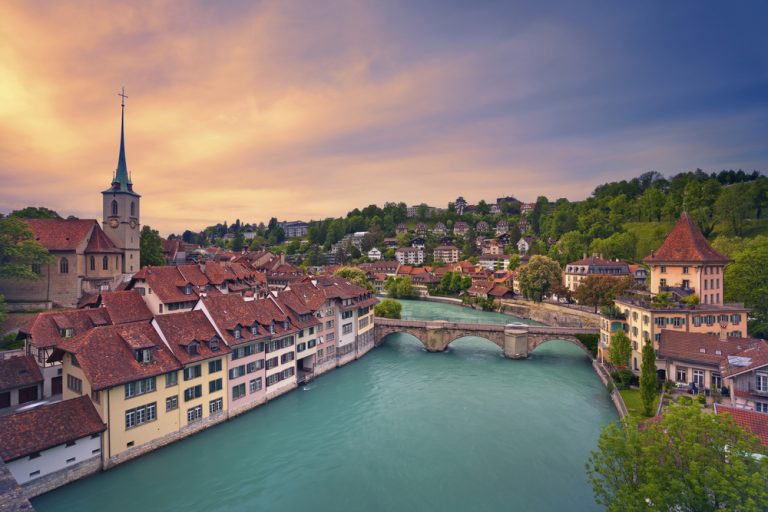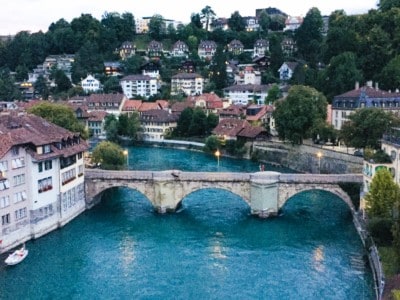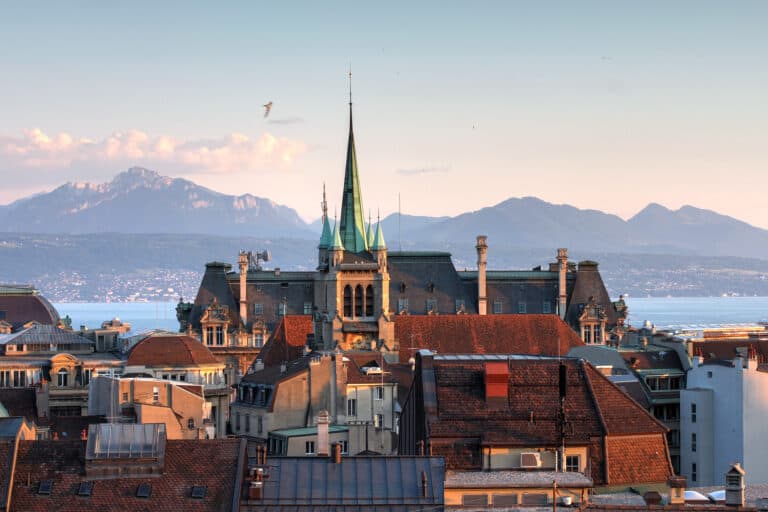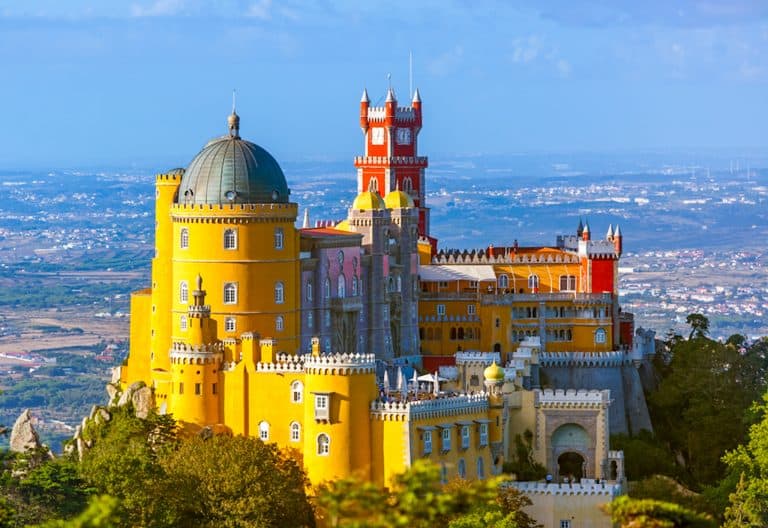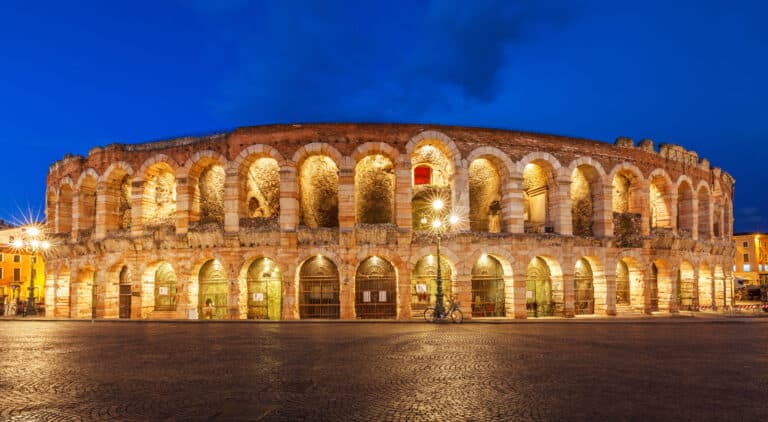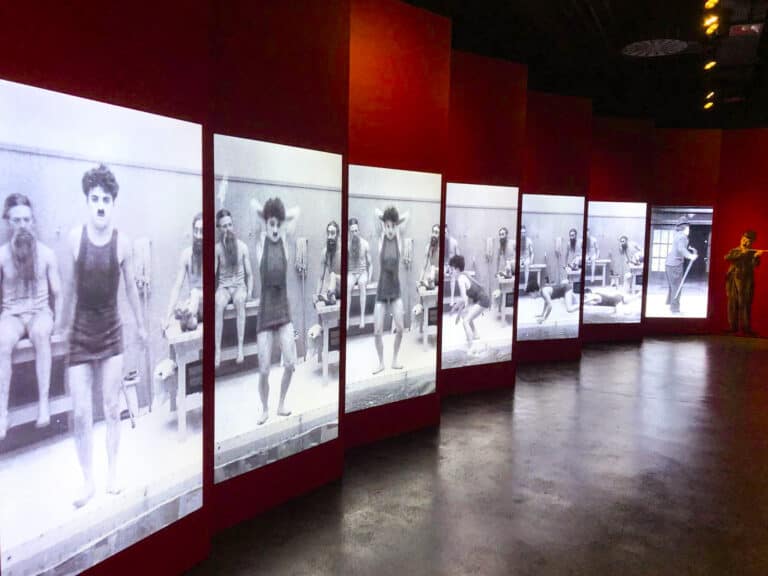Crete: The 17 best things to do in Elounda (2023)

I’ve just returned from a 3 night trip to the small coastal town of Elounda on the north eastern side of Crete and loved it!
Just an hour from the island’s capital, Heraklion, there’s plenty of things to do in Elounda. The stunning scenery, beautiful beaches, charming villages, and proximity to historical sites makes it a perfect place for a short getaway.
Elounda as a short break
Some people had suggested that a trip to a Greek island wasn’t a sensible option for just a short break. The consensus seems to be: spend a week or two in Greece, sightsee, chill out on the beach and get some well-deserved rest and relaxation.
However, having read Victoria Hislop’s ‘The Island’ a couple of years ago, I really wanted to visit. And I didn’t have 2 weeks or even a week for my trip. So I opted for a 3 night/ 4 day mini break.
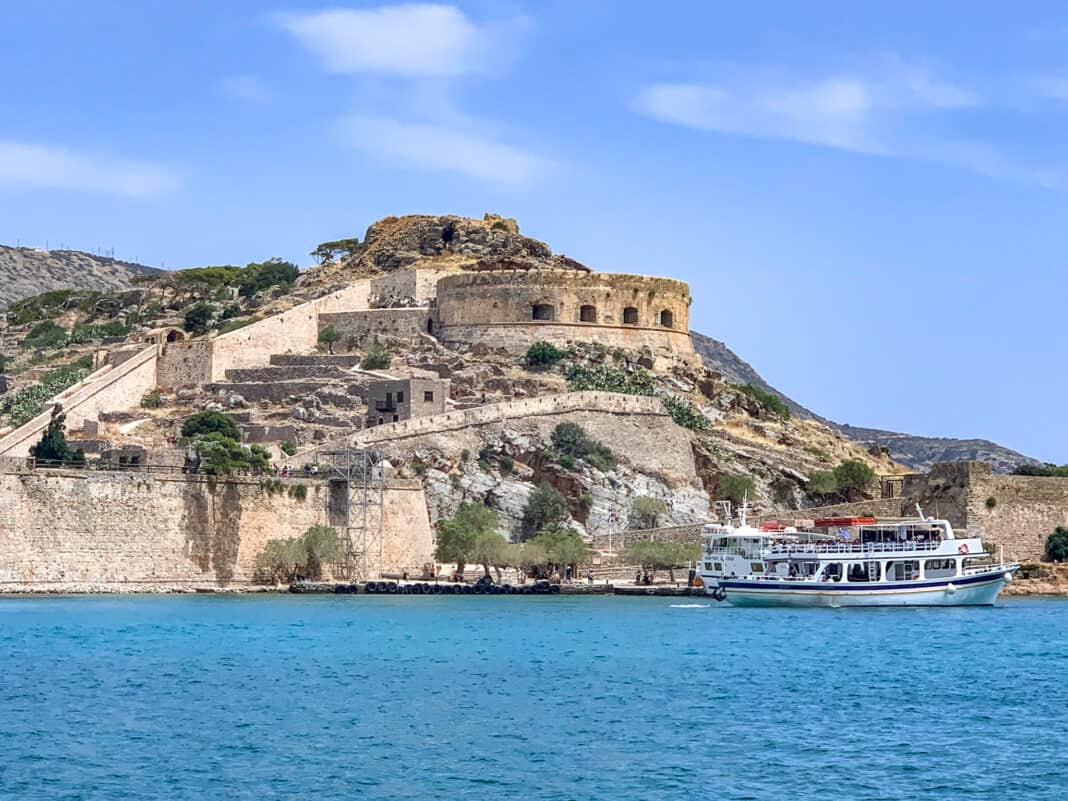
Factoring in only a three and half hour flight from London (less from mainland Europe), it’s really easy to go for just a short break. If you’re interested in Greek islands, I also went on a short break to Corfu Town a few years ago: this has a shorter flight time.
What’s more, if you do have extra time, there’s a lot of interesting things to do in Elounda and around this part of Crete.
Read on for my list of the best things to do in Elounda and information on how to get here and where to stay.
This post contains affiliate links
Where is Elounda?
Elounda is a small town on the north eastern coast of Crete, the largest Greek island in the Mediterranean Sea. It is in the Lasithi region, about 10 km north of the larger town of Agios Nikolaos.
Elounda is also within reach of the popular resort of Malia (around 35 km away), so if you’re staying here it would be a great day trip to put on your list.
The capital, Heraklion, is around 65 km away.
How to get to Elounda
The nearest airport is Heraklion Airport (Nikos Kazantzakis). This just over 65 km to the west of Elounda.
There are several ways to get from the airport to Elounda’s town centre.
By pre-arranged transfer
You can book a transfer in advance that will take you by coach to the centre of Elounda. This takes around 1 hour and 40 minutes as it drops people off in different places along the way. However, it is a reasonably priced option and good value for money.
By taxi
Taxi transfers are also available. These are quicker (about an hour’s drive) but more expensive. But if you only have limited time on Crete and can afford it, this might be the best option as it will drop you directly at your hotel and maximise the time you have.
When we visited in May 2023, taxis from the airport cost between 75 and 85 euros.
By local bus
Getting a local bus to and from the airport is also possible. Note, however, that these run from the nearby town of Agios Nikolaos, so you’d then need to connect to Elounda by either bus or taxi. The buses generally run once an hour, and every half an hour between 6 am and 7.30 am. The journey time is around an hour and half.
This website provides more detail on various bus journeys in the area (although I’d check if your accommodation has more up-to-date listings as we found they changed weekly).
We chose this third option when we returned to the airport. We took a taxi from Elounda to Agios Nikolaos (which cost around 16 euros) and then caught the bus to the airport which cost 7.10 euros per person.
This worked well for us as it allowed us to drop our bags at the airport (there is a drop off booth right next the bus stop). We then hopped onto another bus for 15 minutes, which took us into Heraklion for some sightseeing.
Things to do in Elounda
There are plenty of things to do in Elounda to justify visiting for a short break.
Sail across to the fortified island of Spinalonga
For me, this is probably one of the best places to visit when you’re in Elounda. But I would say that, as I specifically visited Crete to explore this fascinating island and to find out about its turbulent history.
Spinalonga is a small island a mile or so off Crete’s coast facing the tiny village of Plaka. The historic island has a rich and fascinating past and is now one of Crete’s most popular tourist destinations.

The history of Spinalonga island
Thanks to Hislop’s book, the island is well known for its role as a leper colony. In 1903, when the government needed to deal with rising rates of leprosy – at the time, a highly contagious and incurable disease – they decided to quarantine infected people on Spinalonga. They were later joined by others from across Greece.
The island served this purpose until 1957, almost 10 years after medication had been developed to treat the illness.
I knew about Spinalonga as a former leper colony from reading ‘The Island’. What I didn’t realise was that it had a varied and fascinating history that dates back further.
This includes Spinalonga serving as a Venetian military base between the 16th and 18th centuries and as an Ottoman settlement between the early 18th century to the middle of the 19th century. It was also used as a base for British Imperial Airways’ sea planes en route to India in the 1930s.
You can read about these different chapters in the island’s history on the information boards displayed in some of the houses you will find as you explore the now deserted settlement.
What to see on Spinalonga
Your boat from Elounda docks at a small jetty. It’s here that you pay the entrance ticket for entering the settlement. There is also a small shop and café near where the boats dock.
You’ll then walk through a short dark tunnel into the fortress. If you reflect on the fact that hundreds of lepers were banished here, this first impression is quite evocative: you get a sense of the darkness they must have first faced on arrival at the island.
You then emerge into a narrow street lined with pretty houses on one side, notable for their coloured doors and shutters. This is the ‘Market of the Ottoman period’ but was presumably used years later when the lepers arrived. It is a reminder that the island was a home for a sizeable community.

On one of the information boards relating to the leper colony, we are told that ‘neither the restrictions imposed by the regulations nor the objective difficulties of their wretched condition weakened their will to live. They organised their living space, spent time cultivating the land, fell in love, got married and had children’.
It’s worth spending some reading the information provided in the houses here. There are also display cabinets containing some items from the leper colony.
You can then wander around the rest of the island. You’ll see more stone buildings (some having fallen into ruin and others only partially built), parts of the fortress walls, churches, the disinfection kiln from the colony, the remains of the old hospital, and the graveyard.


The disinfection kiln is right next to a massive gate that leads down another jetty and the boats across to the nearest spot on the mainland – Plaka.
There is a path that takes you around the island’s perimeter and from which you get some gorgeous views of the surrounding bay, the mountainous coastline and the sea close by. You can also take a path up to the top. If you have the time, it’s definitely worth exploring and just going to whatever part takes your fancy.
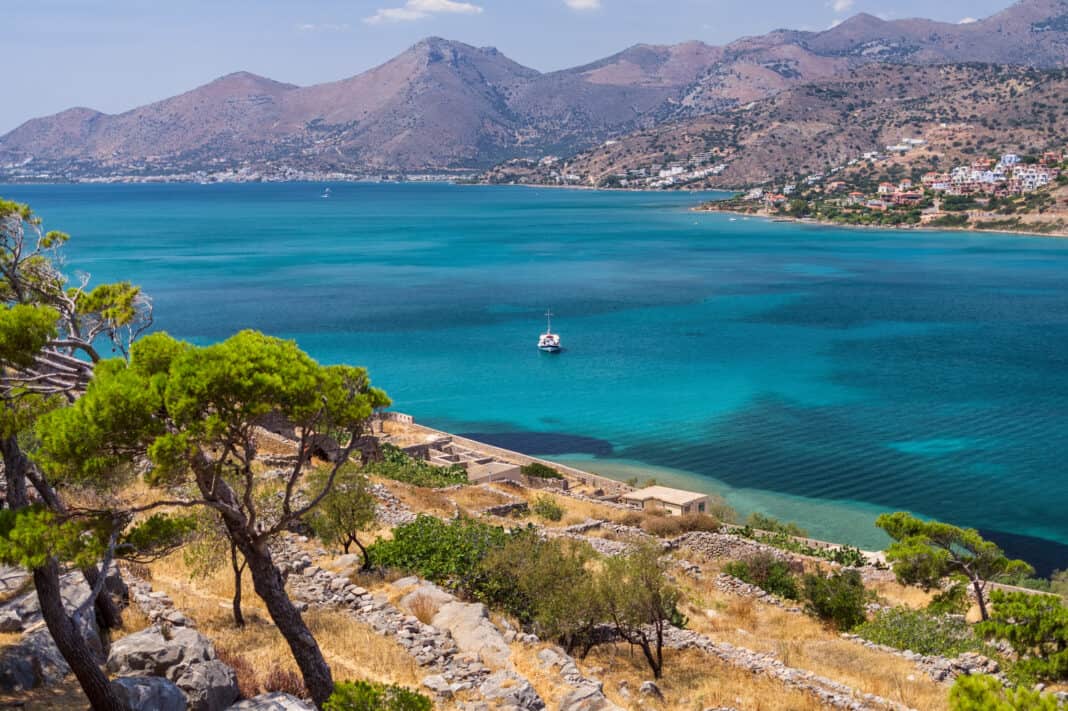
Practical information for visiting Spinalonga
Boats to Spinalonga go from Elounda quayside every half an hour. The trip takes about 25 minutes.
You can also go from nearby Plaka or Agios Nikoloas.
It is 8 euros per person to enter the site. You can explore with a guide or independently.
Note that there are various places on Spinalonga where you may want to go off the main path – in particular, when climbing up to the top of the island.
If you do want to do this (and it is worth it as you get some excellent views), it’s a good idea to wear sensible shoes so you don’t trip on some of the loose rocks. In the summer months, it’s also advisable to take some water and suntan lotion as areas are exposed and it can get very hot (there is, however, a small shop here if you need to buy a bottle).
Explore Elounda town
Elounda town is not big, but it’s a lovely little seaside town to explore. Much of it is centred around the small harbour, which has fishing boats moored up and where you can book a boat to go across to Spinalonga.
Not far away, and dominating the central square, is the striking Agios Konstantinos and Eleni (Saint Constantine and Helen) Orthodox church. You can’t miss this with its whitewashed exterior and pale orange dome. It sits in a small attractive garden with a tall clock tower next to it.

The town has many small shops selling local wares such as homemade olive soap and toiletries, ceramics, and clothes. You can also pick up some local produce, including olives, olive oil, baklava, Greek delight and of course Greek raki!
Dine out on the waterfront
Elounda has a generous smattering of places to stop off for a drink, a meal, or ice cream. There are several bars with outdoor terraces in the square, as well as bars and restaurants lining the harbour side.
We liked Babel, which has tables on a terrace looking out to the boats bobbing up and down on the water.
Our favourite spots, however, were found along the pedestrianised Akti Olountos. There are quite a few small eateries with tables along the seafront, and one has tables on a small beach here. You’re so close you can hear the water lapping up by the side of you.

If you walk for another 5 or 10 minutes along the waterfront and away from the harbour, you’ll find a couple more bars and restaurants.
We particularly enjoyed Ergospasio, which has tables and sofas next to the water and excellent food (try the dolmades!). There’s another small artisan shop here as well.
Try some Cretan food and wine
The restaurants in town serve some delicious Cretan food and wine.
There are loads of meze-type options: dolmades, tzatziki, baked halloumi, feta cheese, saganaki (fried cheese), and salads. If you’re vegetarian or vegan, you’ll be spoilt for choice. You can also get lots of fresh fish and meat dishes.
In the restaurants, they often serve you a small slice of complementary cake after your meal and a glass of raki as a digestive. So you don’t necessarily need to pay for dessert at the end.
And if you don’t fancy waiting until the raki, you can try out some local beer and wine. I tried a few different rose wines, and each one was really tasty.
As you might expect, the more expensive meals are to be found in those restaurants alongside the water. If you want to find something cheaper, or a quick meal, then the town also has a number of small cafes which serve Greek gyros (roasted meat in pitta bread), sandwiches, and fast food.
There are also plenty of places where you can just grab a drink. The places around the quayside are perfect if you fancy a cocktail.
Go on a boat trip
Given its location and the clear waters around the coastline, it’s not surprising that one of the top things to do in Elounda is to take a boat trip. And when you walk around the quayside, there are plenty of boats ready to take people out.
Aside from the boat trips that take you to Spinalonga, there are other activities you can do on the water.
This company offers fishing cruises, as well as half-day swimming cruises. For something more romantic, you can also take one of their thrice-weekly sunset cruises.
If going out on the water is something you particularly want to do, then note that you will likely find a greater range of options in Agios Nikolaos. There are lots of boat trips that go from this larger nearby town.
This boat tour combines a trip to Spinalonga with swimming in Kolkytha bay and a barbecue. This is a great option if you want to combine some sightseeing with a dip in the crystal clear water.
For something more active, you could choose this trip, which includes snorkelling at Skistra Bay.
And for something unique, this semi-submarine cruise takes you down to the depths to see the local marine life (you may be lucky enough to see the caretta caretta turtle (loggerhead sea turtle), said to be the only turtle that nests on the island).
Chill out on the beach
If you’re looking for some rest and relaxation on the beach, you’ll be pleased to know that Elounda has its own beach. The small sandy beach is north of the harbour and just a few minutes’ walk along an esplanade away from the main square.
There are fabulous views from Elounda Beach. As well as looking out into the clear turquoise water in Elounda Bay, you can look back over Elounda village itself in one direction and see an old windmill in another.
There are sunbeds and umbrellas here that you can hire if you’re spending some time chilling out on the beach.
There are also other gorgeous Blue Flag beaches near the main beach in Elounda. Some of the hotels are situated on these beaches, and some of the boat trips stop off in them.
Kolokytha beach is of note – a secluded stretch of sand on a small island connected to Elounda. If you book an organised tour to Spinalonga you may get the opportunity to stop here for a swim.

This tour goes from Agios Nikolas and takes you across Mirabello Bay to Spingalonga. After giving you an hour and a half to explore, you head on to Kolokytha beach to swim, sunbathe, and enjoy a barbecue.
If you go under your own steam, then you can take a picturesque route to it via the old salt pans, past a small canal and some windmills, and along the shoreline.
Eat fish in Plaka overlooking ‘The Island’
The pretty fishing village of Plaka is another place that features heavily in Victoria Hislop’s ‘The Island’. So even though it’s a really tiny place, you can tell that it draws lots of visitors, presumably as a result of the book. It’s around 5 km from Elounda.
There doesn’t seem to be a great deal to do in Plaka village, but it would be a scenic spot to stay if you’re looking for somewhere a bit smaller and quieter.

As noted earlier, you can catch boats over to Spinalonga. In fact, Plaka is the closest place on the mainland to the island, so the journey only takes about 5 minutes (the cost is 10 euros).
It also means that its one of the best spots to get a good view of the island from the coastline: the view is clearer than from Elounda and you get unrivalled views.
You can eat at one of the restaurants lining the main street here. There are several really good fish restaurants if this interests you. A few of these overlook Spinalonga (some overlook Plaka beach). So you could sit looking across to the island while watching the sun go down.
Alternatively, you can browse the crafts shops dotted around the streets and small village square.
You can catch the bus to Plaka from Elounda or take a taxi. You can also walk here although the walk is along the side of the main road and is likely to take up to an hour.
See the sunken lake in Agios Nikolaos
Overlooking Mirabello Bay, Agios Nikolaos is another charming coastal town that’s definitely worth visiting while in Elounda.
Even the journey to get there is worth it: you are awarded stunning views of the bay and surrounding area as your bus or taxi travels high up along the cliffs (just look out for a large cruise ship docked in a bay and you’ll know you’re almost there).
The best place to start sightseeing in Agios Nikolaos is at Lake Voulismeni. This is located in the heart of the town. It was apparently given this name because some people once believed that it was formed as a result of a sunken volcano (Voulismeni means ‘sunken’).
Once you cross the small bridge leading to it, you will see lots cafes and tavernas lining two sides of the lake. However, before you pop into one, walk around the lake (it’s small, so it will only take a few minutes).
At the back of the lake, you’ll notice a tiny little white church that is built into the rock face. You can then climb the steps nearby that will take you up to several different viewpoints from where you can look down on the lake (and part of the town) from up high.
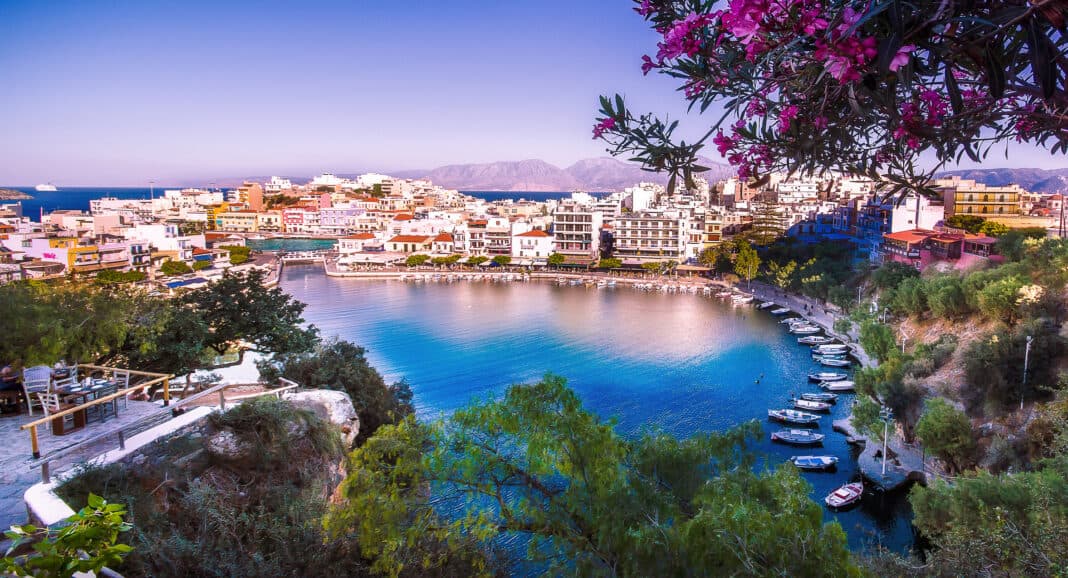
This is the best way to see it, especially at night when the restaurants are lit up. At the top there is a café bar if you want to grab some refreshments after the climb.
Take a stroll up to Agios’ Kitroplateia beach
When I looked up Agios Nikolaos before going, most of the images that came up were of the lake. This is understandable as it’s arguably the main focal point.
However, equally lovely in my opinion, is the vibe you get around Kitroplateia beach. This is about a 10-minute walk away from the lake.
As with Elounda, it’s a small town beach – but it’s big enough to relax on and has sunbeds and umbrellas. You can also swim here.
Behind the beach is a small stretch of bars and tavernas. However, we preferred those on the walkway along the side of the bay. Here you can sit and eat with the noise of the water crashing up against the side of the buildings.
We chose to eat out here and weren’t disappointed. The fresh fish we ordered was amazing, and the setting – looking out to sea – was near perfect.

Other things to do in Agios Nikolaos
Other things to do in Agios include visiting the town’s archaeological museum. This houses a collection of artefacts from this part of the island’s various archaeological sites.
The town is also pleasant to wander around. The street parallel to the side of the lake (near the small bridge) is worth exploring. It has some souvenir shops and boutiques that you can browse and buy souvenirs in.
Visit the capital, Heraklion
Crete’s capital Heraklion is around an hour and a half by local bus from Agios Nikolaos (you can connect to Agios from Elounda via bus or taxi).
The bus goes via the airport so you could do what we did and go sightseeing before your flight home. There is a left luggage booth right by the bus stop. Alternatively, you could go straight into the city.
There are many things to do in Heraklion and how you decide to occupy your time will depend on your interests and available time. You can walk around the sights yourself or catch the hop-on/ hop-off bus.
Go out to Knossos Palace
Knossos Palace in Heraklion is a must-visit destination for history lovers and anyone interested in ancient Crete. It is regarded as the most important archaeological site on the island and dates back to the Neolithic period.
The palace is associated with the Minoan civilisation, one of the earliest advanced societies in Europe. It’s also a place that is associated with ancient Greek mythology. For anyone who has read any Greek mythology, this is said to be where the Minotaur, a half-human, half-bull creature lived in the labyrinth underneath the palace.
For us, a trip out to Knossos Palace was the highlight of our time in Heraklion.
Getting out to Knossos Palace
Knossos is only a few kilometres from the city centre and about a 20-minute bus ride.
Knossos Palace is included as part of the city’s hop-on/ hop-off bus. It’s around 20 minutes outside of the main centre.
However, if you only have time to go to Knossos when you’re in Heraklion, it is much cheaper to get here using the local buses. In addition, as some of the sights on the tour bus require you to get off and walk to them as they’re in pedestrianised areas, then you might want to think about how much value for money this would be for you.
Tours to Knossos Palace
You can book an organised tour to take you around the site. These types of tours have the benefit of being accompanied by a guide who can tell you all about the history of Knossos Palace as you make your way around.
You can also combine a tour of Knossos Palace with other local sightseeing.
This tour starts with a visit to the Lasithi Plateau, notable for its small picturesque villages, windmills and the Dikteon Cave (this is where Zeus was said to have been born). You also visit a local monastery and finish up at Knossos.
Visiting Knossos Palace
On a visit here, you will see parts of the palace that were excavated and, in some places, reconstructed in the early 20th century by a team led by the British archaeologist Sir Arthur Evans. You can wander past the remnants of the palace, and see some of the frescoes and pottery which have been uncovered (some are also in the Heraklion Museum, which you can also visit while in the city).
Much of the complex is in ruins, but there are some parts where you can really see the splendour of a palace that once was.
There are also some interesting rooms to go in. In the Throne Room – considered Europe’s oldest – you can see stone benches and bright, colourful frescos on the walls. In the Royal Apartments there are fascinating frescos and coloured walls and pillars.

There’s also the striking North entrance with red and black columns and a fresco of a bull.

Knossos Palace is a remarkable archaeological site, and I’m glad we went. Whether you are a history enthusiast, a mythology lover, or simply curious about ancient cultures, it’s worth the short trip out here.
There is also a small shop at the entrance and a café if you need a break before returning to the city. And if you fancy lunch, there’s the Pasiphae restaurant a short walk from the car park where the bus drops you off. I’d recommend this – the food was great.
You can buy skip-the-line tickets to Knossos Palace here.
Wander around the city centre and have a drink overlooking the Lions Fountain
We wandered through the city centre, looking at some of the grand neoclassical buildings lining the streets. The Venetian Loggia – Heraklion Town Hall – is particularly impressive. As well as looking at it from the outside, go up the steps and take a peek inside.
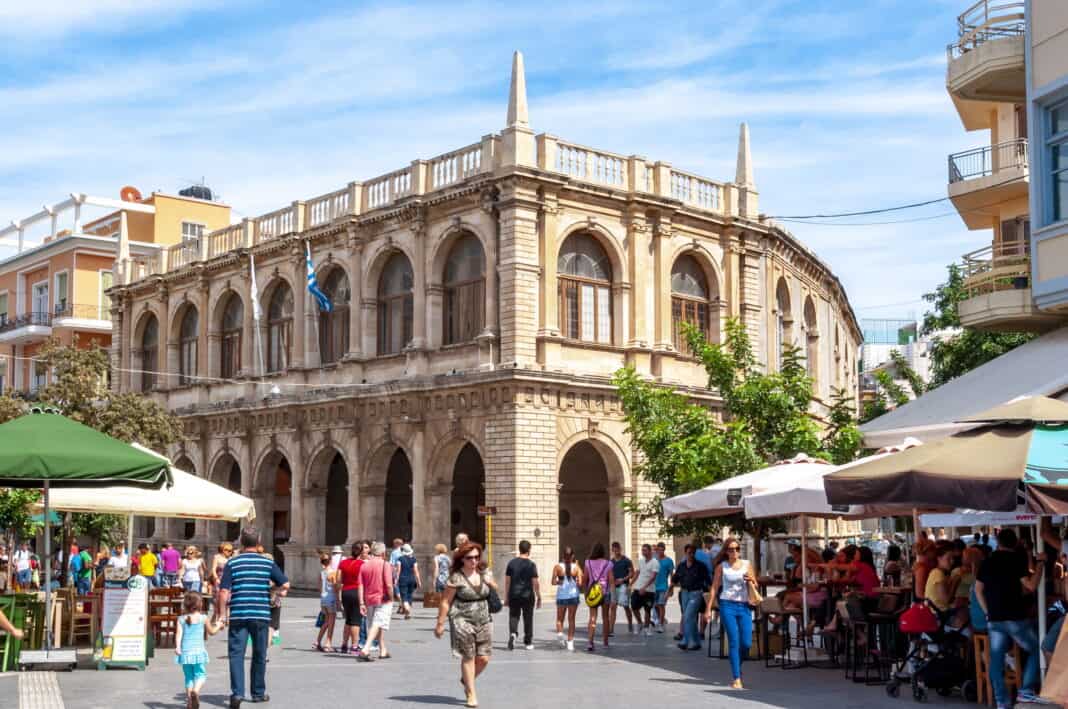
The Town Hall is near the Lions Fountain (the Morosini Fountain in Eleftheriou Venizelou Square). The fountain, built during the reign of the Venetians on the island, has a central statue surrounded by four lion sculptures.
This square is arguably one of the best places in the capital to stop for a drink. There are several cafes and restaurants with outdoor terraces overlooking the fountain.
It is really quite atmospheric in the evening as people sit drinking wine, eating appetisers and listening to buskers playing music. At night, the fountain is lit up.
Explore the old Venetian fortress
One thing you can’t miss seeing in Heraklion is its impressive Venetian fort, Koules Fort (this means fortress in Turkish), and otherwise known as the Rocca a Mare fortress. It sits in the harbour and was built to protect the city from invasion.
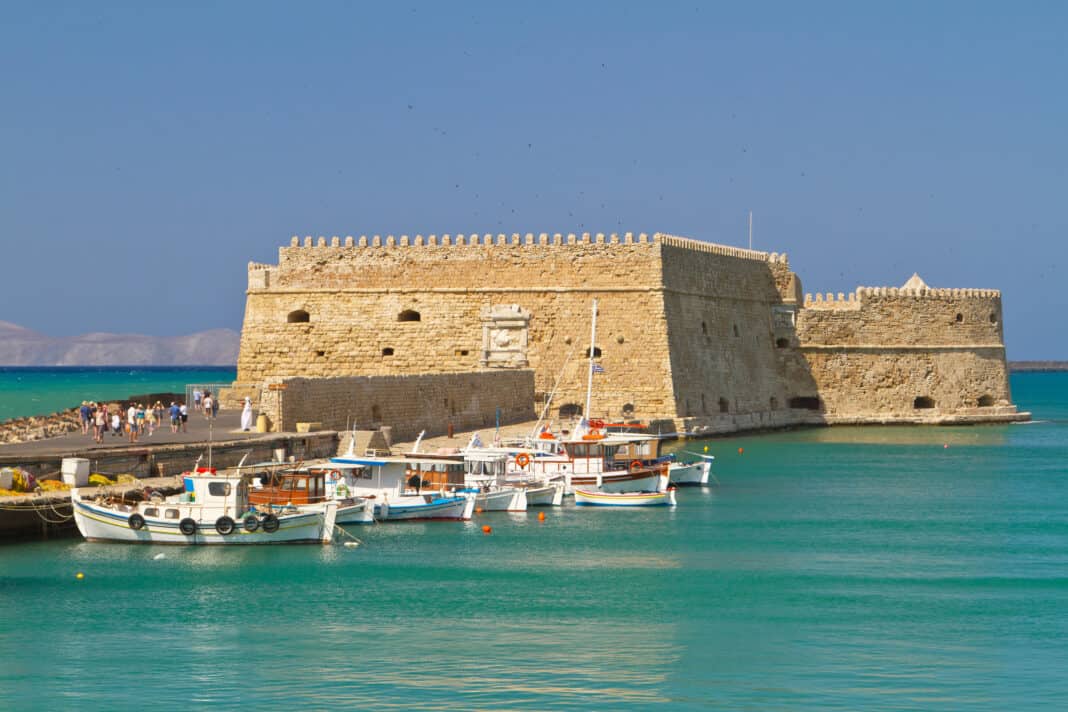
You can walk down to the fortress and pay a small entrance fee to go inside. The ticket allows you to wander around the square structure and admire its massively thick stone walls.
You can also go inside to look at some of the artefacts on display. There are information boards dotted about so you can learn more about the fortress, and a small museum.
A top tip is to walk up to the ramparts for the amazing views you will get when you look out over the harbour and sea.
Learn more about the history of Crete
Heraklion has several archaeological and history museums that you can visit while on a trip here and where you can learn more about the history of Crete.
The Heraklion Archaeological Museum houses a vast collection of Minoan artefacts, including pottery, sculptures, jewellery, coins, art, and frescoes. It also has some relics from Knossos Palace. It’s an excellent place to learn more about the history and culture of Crete.
There is also the Historical Museum of Crete. This presents the history of Crete from early Christian times to the modern era. It also contains exhibits on the Cretan involvement during World War II. The museum also holds the only El Greco works on the island.
Visit other museums in Heraklion
In addition to the main history museums in the city, there is also the Natural History Museum. This showcases the rich biodiversity and geological heritage of Crete and has a variety of exhibits related to animals, dinosaurs, plants and earthquakes.
For art lovers, there is the Museum of Visual Arts of Heraklion and the Vasiliki Agios Markos Municipal Art Gallery. There’s also a science and technology museum – the Kotsanas Museum.
And for lovers of marine life, there is the Cretaquarium, the largest aquarium in Greece.
Buy some souvenirs on 1866 street
Not far from the Lion’s Fountain is 1866 Street (so named after the revolt that took place on the island in 1866).
This street is home to Heraklion’s Central Market, a busy and bustling city artery lined with stalls selling all manner of items and wares. It’s another place to pick up souvenirs or shop for local produce.
There are natural sponges, handmade wooden cooking utensils and ceramics, spices, fruit and veg, clothes, as well as fridge magnetics for the tourist who wants a memory of their time here. I suspect you can find most things you’re looking for here.
There are also a few small eateries along the street if you want to stop and try local food.
Hike to the Richtis Waterfall
For those of you who want to get out of the towns and cities and see more of the countryside, or who are more interested in outdoor activities, a visit to the Richtis Waterfall might be for you.
The waterfall is in the Richtis Gorge near the village of Exo Mouliana. The 3 km hike takes you along treelined pathways, past rivers, and olive trees, over wooden bridges, and then down into a ravine.
The waterfall plunges 20 metres to a pool at the bottom that you can take a dip in. You can then top this off with a swim in the sea at the nearby Richtis beach.
It should be noted that the hike takes about 3 to 4 hours, and some parts are uphill. Depending on the time of year you visit, you will also need to consider the right time to visit to avoid the heat of the day.
If this interests you, you can book organised tours that will take you to the gorge and the waterfall and drive you some of the way. Doing it this way limits the actual hike to 20 to 30 minutes.
Where to stay in Elounda
There’s no shortage of places to stay to suit all budgets – be they small apartments or luxury hotels/ luxurious resorts – each offering different experiences.
- We stayed in Elounda Garden Suites and would highly recommend this. It’s only a small place but has some attractive apartment rooms with balconies, a gorgeous pool area, and a small bar. The added bonus is that it’s only a five-minute walk into Elounda, so it has a perfect location. In an area where there are several high-end luxury resorts, this is a more reasonably priced option.
- Kavos Bay apartments is a reasonably priced option if you want the privacy of staying in an apartment or prefer to self cater. There is a pool and wonderful views out to sea. Shops and restaurants are within walking distance and there is an on-site mini market and bar.
- Domes of Elounda is a luxury hotel situated between Elounda and Plaka. There are 3 pools here (one indoor), 4 restaurants, and a spa and fitness centre. There are fantastic views across to Spinalonga. This is the perfect place for a romantic break (but note that prices are at the top end).
- The Elounda Palm Hotel and Suites is another more reasonably priced option. The complex sits in beautiful gardens, and some rooms have stunning sea views. There are two pools, a fitness centre, and 2 restaurants.
- Blue Palace Elounda is another luxurious hotel on the beachfront with a view across to Spinalonga (it is just a five minute walk from Plaka). It has a private beach area, 3 swimming pools, a tennis court, watersports, a spa, wellness, and fitness centre, as well as a range of other services that include some that cater for children. It also has a water sports centre.
You can explore other options in the area here.
Other ideas for short breaks in Europe
If you go to Elounda, Crete, I hope you enjoy it as much as we did. It’s a great place for a short break, with beautiful scenery, lovely little villages to explore, stunning beaches and fantastic food. It’s the perfect destination!
If you want to read about other places to consider for a short break or weekend away, then some of my other posts might interest you.
In particular, you might find my post on the things to do in Corfu Town in Greece of interest.
I have also written about short breaks to Venice, to the capital of Slovakia, Bratislava, to Brussels in Belgium, to the Italian Lakes and to several destinations in Switzerland.
For other ideas, see my website.


